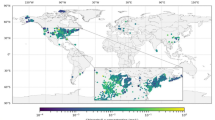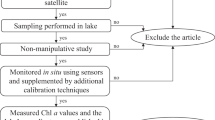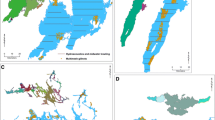Abstract
The Water Framework Directive (WFD) requires EU Member States to assess the “ecological status” of surface waters. As a component of ecological status, many European countries are developing a classification scheme for chlorophyll concentrations as a measure of phytoplankton biomass. The chlorophyll classification must be based on the degree of divergence of a water body from an appropriate baseline or ‘reference condition’. This article describes the development of a series of regression models for predicting reference chlorophyll concentrations on a site-specific basis. For model development, a large dataset of European lakes considered to be in reference condition, 466 lakes in total, was assembled. Data were included from 12 European countries, but lakes from Northern and Western Europe dominated and made up 92% of all reference lakes. Data have been collated on chlorophyll concentration, altitude, mean depth, alkalinity, humic type, surface area and geographical region. Regression models were developed for estimating site-specific reference chlorophyll concentrations from significant predictor ‘typology’ variables. Reference chlorophyll concentrations were found to vary along a number of environmental gradients. Concentrations increased with colour and alkalinity and decreased with lake depth and altitude. Forward selection was used to identify independent explanatory variables in regression models for predicting site-specific reference chlorophyll concentrations. Depth was selected as an explanatory variable in all models. Alkalinity was included in models for low colour and humic lakes and altitude was included in models for low colour and very humic lakes. Uncertainty in the models was quite high and arises from errors in the data used to develop the models (including natural temporal and spatial variability in data) and also from additional explanatory variables not considered in the models, particularly nutrient concentrations, retention time and grazing. Despite these uncertainties, site-specific reference conditions are still recommended in preference to type-specific reference conditions, as they use the individual characteristics of a site known to influence phytoplankton biomass, rather than adopt standards set to generally represent a large population of lakes of a particular type. For this reason, site-specific reference conditions should result in reduced error in ecological status classifications, particularly for lakes close to typology boundaries.





Similar content being viewed by others
References
Arvola, L., P. Eloranta, M. Järvinen, J. Keskitalo & A.-L. Holopainen, 1999. Phytoplankton. In Eloranta, P. & J. Keskitalo (eds), Limnology of Humic Waters. Backhuys Publishers, Leiden: 137–171.
Cardoso, A. C., A. Solimini, G. Premazzi, L. Carvalho, A. Lyche Solheim & S. Rekolainen, 2007. Phosphorus reference concentrations in European lakes. Hydrobiologia 584: 3–12.
Carvalho, L., A. Solimini, G. Phillips, M. van den Berg, O.-P. Pietiläinen, A. Lyche Solheim, S. Poikane & U. Mischke, 2008. Chlorophyll reference conditions for European intercalibration lake types. Aquatic Ecology 42: 203–211.
CIS, 2003. River and lakes—typology, reference conditions and classification systems. Common Implementation Strategy for the Water Framework Directive (2000/60/EC), Guidance document 10, European Commission: 86 [available on internet at http://circa.europa.eu].
Clarke, R., L. Carvalho & S. Maberly, 2006. Uncertainty in chlorophyll and total phosphorus classifications. In Carvalho L., G. Phillips, S. Maberly & R. Clarke, Chlorophyll and Phosphorus Classifications for UK Lakes. Final Report to SNIFFER (Project WFD38), Edinburgh [available in internet at http://www.sniffer.org.uk/].
Dillon, P. J., 1974. A critical review of Vollenweider’s nutrient budget model and other related models. Water Research Bulletin 10: 969–989.
Dillon, P. J. & W. B. Kirchner, 1975. The effects of geology and land use on the export of phosphorus from watersheds. Water Research 9: 135–148.
Directive, 2000. Directive 2000/60/EC of the European Parliament and of the council of 23 October 2000 establishing a framework for community action in the field of water policy. Official Journal of the European Communities L327: 1–72.
Fee, E. J., 1976. The vertical and seasonal distribution of chlorophyll in lakes of the Experimental Lakes Area, Northwestern Ontario: implications for primary production estimates. Limnology & Oceanography 21: 767–783.
Freeman, C., N. Fenner, N. J. Ostle, H. Kang, D. J. Dowrick, B. Reynolds, M. A. Lock, D. Sleep, S. Hughes & J. Hudson, 2004. Export of dissolved organic carbon from peatlands under elevated carbon dioxide levels. Nature 430: 195–198.
Greisberger, S. & K. Teubner, 2007. Does pigment composition reflect phytoplankton community structure in differing temperature and light conditions in a deep alpine lake? An approach using HPLC and delayed fluorescence (DF) techniques. Journal of Phycology 43: 1108–1119.
Jacobsen, T. R. & H. Rai, 1990. Comparison of spectrophotometric, fluorometric and high performance liquid chromatographic methods for determination of chlorophyll a in aquatic samples: effects of solvent and extraction procedures. Internationale Revue der gesamten Hydrobiologie 75: 207–217.
Jeffrey, S. W. & G. F. Humphrey, 1975. New spectrophotometric equations for determining chlorophylls a, b, c1 and c2 in higher plants, algae and natural phytoplankton. Biochemie und Physiologie der Pflanzen 167: 191–194.
Jeppesen, E., Ma. Søndergaard, Mo. Søndergaard & K. Christoffersen (eds), 1998. The structuring role of submerged macrophytes in lakes. Springer Verlag, New York.
Lorenzen, C. J., 1967. Determination of chlorophyll and pheopigments: spectrophotometric equations. Limnology & Oceanography 12: 343–346.
Monteith, D. T., J. L. Stoddard, C. Evans, H. de Wit, M. Forsius, T. Hogasen, A. Wilander, B. L. Skelkvale, D. S. Jeffries, J. Vuorenmaa, B. Keller, J. Kopacek & J. Vesely, 2007. Dissolved organic carbon trends resulting from changes in atmospheric deposition chemistry. Nature 450: 537–541.
Moss, B., P. Johnes & G. Phillips, 1996. The monitoring of ecological quality and the classification of standing water in temperate regions: a review and proposal based on a worked scheme for British waters. Biological Review 71: 301–339.
Poikane, S., M. van den Berg, J. Ortiz-Casas, G. Phillips, A. Lyche Solheim, D. Tierney, G. Wolfram & P. Nõges, 2009. Lake assessment strategy in European Union (EU): case study of European large lakes. Verhandlungen der Internationalen Vereinigung für Theoretische und Angewandte Limnologie 30: 1007.
Reynolds, C. S., 2006. Ecology of Phytoplankton. Cambridge University Press, Cambridge.
Sakamoto, M., 1966. Primary production by phytoplankton community in some Japanese lakes and its dependence on lake depth. Archiv für Hydrobiologie 62: 1–28.
Salonen, K., A.-L. Holopainen & J. Keskitalo, 2002. Regular high contribution of Gonyostomum semen to phytoplankton biomass in a small humic lake. Verhandlungen der Internationalen Vereinigung für Theoretische und Angewandte Limnologie 28: 488–491.
Scheffer, M., 1998. Ecology of Shallow Lakes. Kluwer Academic Publishers, Dordrecht.
Small, L. F., 1963. Effect of wind on the distribution of chlorophyll a in Clear Lake, Iowa. Limnology & Oceanography 8: 426–432.
Søndergaard, M., E. Jeppesen, J. P. Jensen & S. L. Amsinck, 2005. Water Framework Directive: ecological classification of Danish lakes. Journal of Applied Ecology 42: 616–629.
USEPA, 2000. Nutrient Criteria Technical Guidance Manual. Lakes and Reservoirs. Environment Protection Agency, Office of Water and Technology, Washington, DC.
Van de Bund, W., A. C. Cardoso, A.-S. Heiskanen & P. Nõges, 2004. Overview of Common Intercalibration types. Electronic document [available on internet at http://wfd-reporting.jrc.cec.eu.int/Docs/typesmanual.
Vighi, M. & G. Chiaudani, 1985. A simple method to estimate lake phosphorus concentrations resulting from natural, background, loadings. Water Research 19: 987–991.
Vollenweider, R. A. & J. Kerekes, 1982. Eutrophication of waters. Monitoring, assessment and control. OECD Cooperative programme on monitoring of inland waters (Eutrophication control), Environment Directorate, OECD, Paris: 154 p.
Acknowledgements
This study was part-financed by the European Framework 6 Project REBECCA ‘Relationships Between Ecological and Chemical Status of Surface Waters’, Contract No.: SSPI-CT-2003-502158. We would like to thank our colleagues in the project, in particular those that supplied their data and those responsible for the database. We would also like to thank the GIG coordinator Sandra Poikane and GIG representatives and data providers for their cooperation and comments on aspects of the work.
Author information
Authors and Affiliations
Corresponding author
Additional information
Guest editors: P. Nõges, W. van de Bund, A. C. Cardoso, A. G. Solimini & A.-S. Heiskanen
Assessment of the Ecological Status of European Surface Waters
Rights and permissions
About this article
Cite this article
Carvalho, L., Solimini, A.G., Phillips, G. et al. Site-specific chlorophyll reference conditions for lakes in Northern and Western Europe. Hydrobiologia 633, 59–66 (2009). https://doi.org/10.1007/s10750-009-9876-8
Published:
Issue Date:
DOI: https://doi.org/10.1007/s10750-009-9876-8




